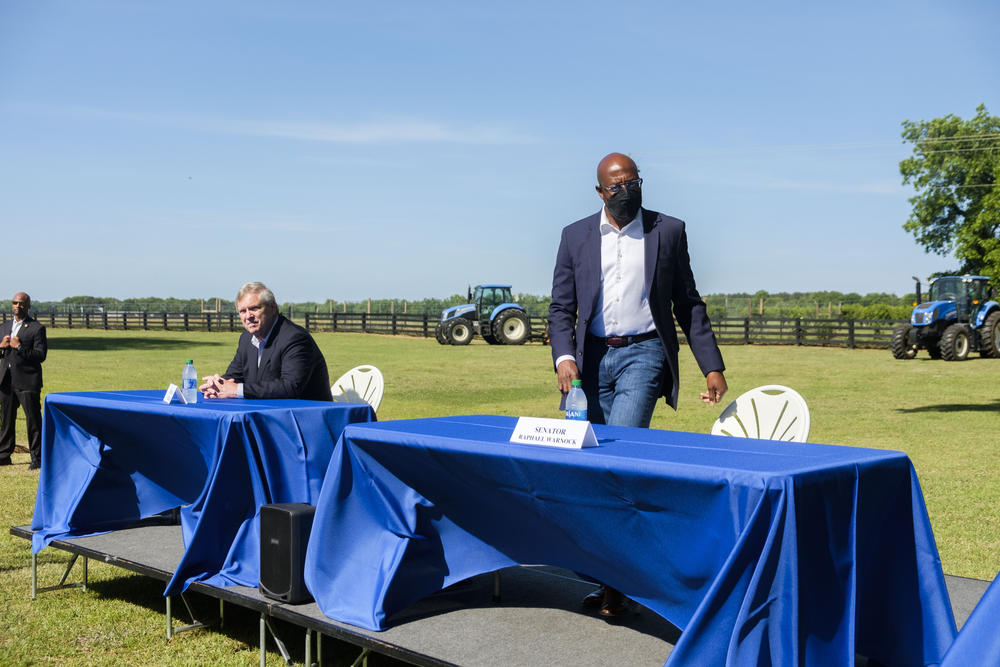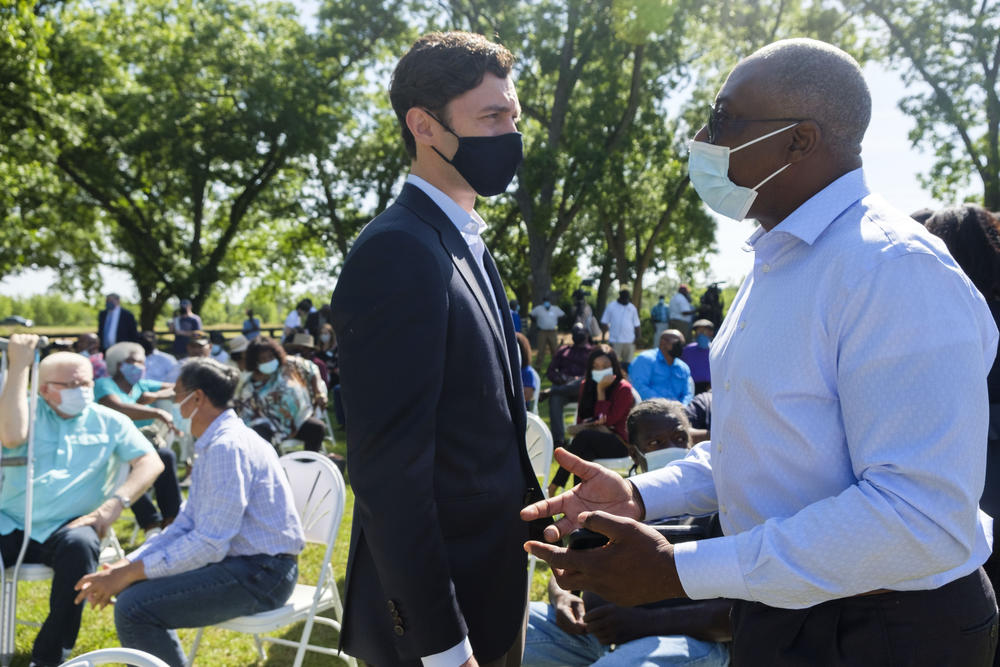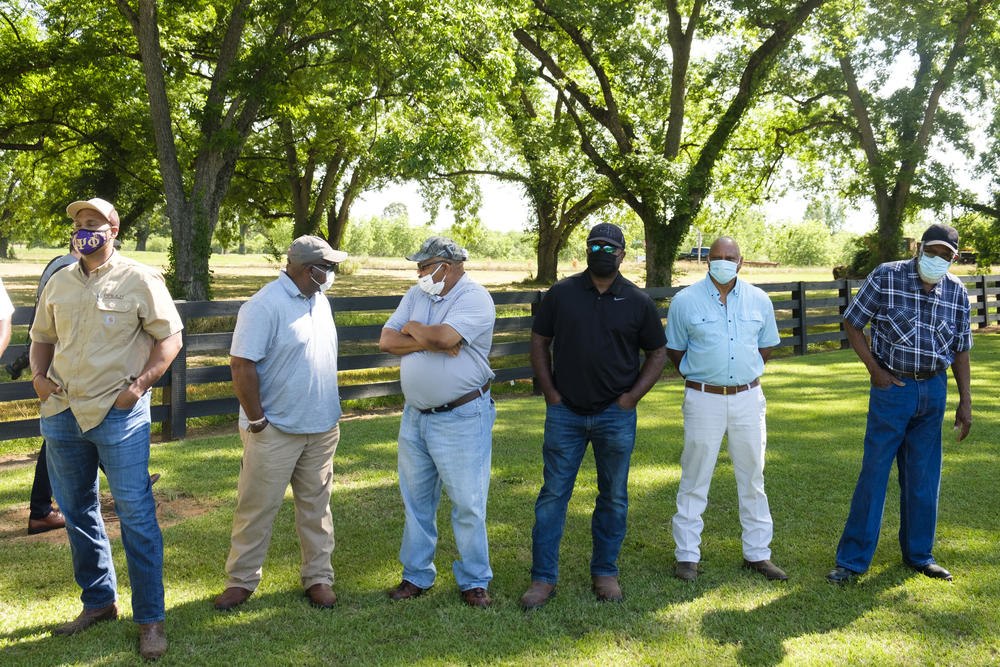
Caption
Sen. Raphael Warnock, right, takes his seat next to USDA Secretary Tom Vilsack at an event held at Fort Valley State University to explain new USDA debt aid to Black farmers.
Credit: Grant Blankenship

Sen. Raphael Warnock, right, takes his seat next to USDA Secretary Tom Vilsack at an event held at Fort Valley State University to explain new USDA debt aid to Black farmers.
Next month, some Black farmers will be able to access part of $4 billion set aside for debt cancellation. It’s a historic amount of money, courtesy of the American Rescue Plan, aimed at redressing generations of inequity in farm lending by the federal government. But for some, this aid does not go far enough.
Details about the plan were shared with about 100 present and former farmers at a press event at Fort Valley State University last weekend. In short, up to 120% of debt held by the USDA will be canceled for “socially disadvantaged farmers.” Mainly this means Black farmers, but Hispanic and Native American farmers are included, too.
A crucial detail: The aid definitely only helps farmers who succeeded in getting a loan from the historically discriminatory USDA in the first place. Willie Head, a Brooks County farmer, said that’s the problem.
“That sounds good, and it will work for those who are with the USDA,” Head said. “But there are so many they know nothing about that are not in USDA.”
Over 20 years ago, the USDA acknowledged it had purposely kept Black farmers out of its programs. That was made clear when the agency settled to the tune of $1 billion in what is known as the Pigford settlement.
But thousands of farmers were left out of Pigford, and an additional $1 billion in settlement money was never authorized by Congress. That’s why former farmer Leo Jackson, who left farming about the time of Pigford, in part because he was never able to secure a USDA loan, had little optimism about what USDA Secretary Tom Vilsack had to say Saturday.
“We had thousands and thousands of meetings like this with all kinds of senators, all kinds of congressmen, everybody,” Jackson said. “Presidents. Bill Clinton, George Bush, Barack Obama, Donald Trump and now Joe Biden. We lost our land. We lost our house. We lost our family. We lost everything. And well, we get out here and get a soda and some peanuts.”

Poultry farmer Julian Marcus, right, explains to Sen. Jon Ossoff how he is still in debt after making repairs on the farm caused by Hurricane Irma in 2017. The USDA debt relief will not be of direct aid to Marcus.
While it’s Sen. Raphael Warnock who is taking the credit for the new aid package nestled into the American Rescue Plan, and who has the most riding on at least the perception of its success as he looks ahead to reelection next year, it’s Vilsack who must administer the program he said is an acknowledgement that farmers such as Jackson had been systemically locked out of capital by the government.
“When people do not have full access to the broad array of services and benefits at the Department of Agriculture over that period of time, they are at a severe disadvantage,” Vilsack said. “White farmers obviously had the full advantage; they had all the programs. And so they had a chance to grow, to expand, to buy the best equipment, to plant their crop in a timely way.”

Farmers taking in the nuances of the $5 billion total aid package for "socially disadvantaged" farmers nestled in the American Rescue Plan at an informational event at Fort Valley State University.
That is the history of farm lending, in brief, for Sylvester Bembry’s family. Bembry is the fourth generation to farm his family’s land in Pulaski County. He came to hear Vilsack and Warnock as well as House Rep. Sanford Bishop and Sen. Jon Ossoff in hopes of learning how the new aid would help him.
“Well, my parents, I mean, they were farmers,” Bembry said. “They actually farmed. That's how they made a living. That's how they raised us on the farm.”
Bembry, 65, wants to pass the farm to his nephew Dwayne, 20 years his junior, to make five generations of Bembrys on the land. But there’s a snag. When his parents died, they left a debt he’s yet to fully overcome — a debt that arose because of discrimination at the bank.
“It was like April and May before they got the loan,” Bembry said. “Well, the white landowner, they got the money back in February, March.”
That meant that white farmers had access to loans to get seed in the ground. Bembry’s parents would get their loans well into the growing season, likely doomed to lesser yields and profits than their white neighbors.
“Well, I mean, heck, it's kind of late to get land prepared because the funds weren't there,” Bembry said. “So and that's what kind of put them back in the hole down through the years.”
Bembry estimated he’s missed out on 15 years of progress on the family farm as a result. And though that sounds like the generational inequity Congress and the USDA say the new aid is there to address, it won’t touch Bembry’s bank loans. There will be no immediate help for him. He said he’s disappointed.
“I mean, it's going to take us another seven, eight years to, you know, just clear the debt up,” Bembry said. “And that's going to throw us even further behind in the future.”
There is, however, a provision in the aid package for a future congressional “equity commission” that will tackle the deeper, more systemic issues in farm lending. And there’s $1 billion set aside for grants to farmers for things such as equipment, farm improvements and to help access equitable lending.
Farmers who qualify for the USDA debt cancellation can expect the aid to begin in June.